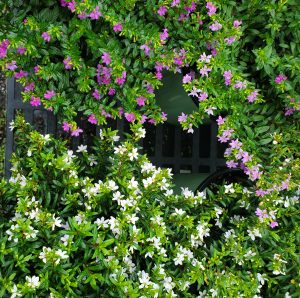
Again – under the umbrella of variety – I wanted to bring to your attention the fact that many common landscape plants can come in different color variations to the benefit of your plant palette. One such plant which I have written about in the past is called false heather or Cuphea hyssopifolia, a native of Mexico, Guatemala, and Honduras. There is no better small groundcover with very fine leaves and tiny, but distinct flowers in purple, pink or white – including many named cultivars.
Only a foot or two in height, and maybe up to three feet wide given time, the false heather has very dense growth and a well-rounded shape. The small, lance-shaped leaves fill the branches with numerous flowers emerging at the juncture of leaf and stem. The flowers are purple, pink, or white depending on the cultivar and are trumpet-shaped with six petals. Pollinators appreciate these flowers and often visit false heather – bees and butterflies love it! Although most of the flowers occur summer through fall, false heather can have some flowers year-round.
Best in full-sun to part-shade sites, plant false heather at twenty-four-inch intervals if mass-planted. Also consider using Cuphea for planting bed edging and borders. Taking our summer heat extremely well, false heather is drought-tolerant and moderately salt-tolerant. While false heather can sometimes self-seed producing more plants, this perennial subshrub is not a problem species at this time as far as invasiveness is concerned according to the UF/IFAS Assessment of Non-Native Plants in Florida’s Natural Areas. Also, while false heather is generally hardy in our area, any freeze damage experienced in the winter will grow back.
Now for your cultivar hunt. The most common cultivar you may encounter is called ‘Allyson’ – a very compact variety with purple-lavender flowers. One white cultivar to look for is called ‘Mexican Heather White’ – same plant, just a different color flower. You can also find various shades of pink as well. Additional work has produced improved cultivars such as the Floriglory® series with exceptional flowering characteristics including ‘FloriGlory® Corazon’, ‘FloriGlory Diana’, ‘FloriGlory® Selena’, ‘FloriGlory® Maria’, and ‘FloriGlory® Alonso’.
The main pest encountered locally that can be a problem is the flea beetle. This tiny metallic or stripped beetle actually hops like a flea and feeds on the leaves. In addition to the adult beetle, you will also notice small larvae feeding on the leaves. While your false heather may never have flea beetles, you should monitor for them regularly to prevent an infestation from building up to damaging levels.
False heather is still a Florida-Friendly Landscaping™- approved plant that we would recommend. A small plant, which makes a mighty groundcover, false heather should be in your landscape – purple, pink, and white included! For information on all types of Florida-Friendly Landscape™ plants suitable for Southwest Florida, or to ask a question, you can also call the Master Gardener Volunteer Helpdesk on Mondays, Wednesdays, and Fridays from 1 to 4 pm at 764-4340 for gardening help and insight into their role as an Extension volunteer. Ralph E. Mitchell is the Director/Horticulture Agent for UF/IFAS Extension Charlotte County. He can be reached at 941-764-4344 or ralph.mitchell@charlottecountyfl.gov. Connect with us on social media. Like us on Facebook @CharlotteCountyExtension and follow us on Instagram @ifascharco.
Resources:
Gilman, E. F. (1999) Cuphea hyssopifolia. The University of Florida Extension Service, IFAS.
UF/IFAS Assessment of Non-Native Plants in Florida’s Natural Areas. (2023) Cuphea hyssopifolia.
Missouri Botanical Garden (2021) Cuphea hyssopifolia. https://www.missouribotanicalgarden.org/PlantFinder/PlantFinderDetails.aspx?kempercode=a113 .
North Carolina Extension Gardener Plant Toolbox. https://plants.ces.ncsu.edu/plants/cuphea-hyssopifolia/ .
The Florida-Friendly Landscaping™ Guide to Plant Selection & Landscape Design. (2022) The University of Florida Extension Service, IFAS.
Caldwell, D. (2020) Cuphea Chewers! Is your Mexican heather, Cuphea hyssopifolia, shrinking? The University of Florida Extension Service, IFAS – Collier County.
GRAMMARIST (2023) Variety is the spice of life. https://grammarist.com/idiom/variety-is-the-spice-of-life/.
Source: UF/IFAS Pest Alert
Note: All images and contents are the property of UF/IFAS.



